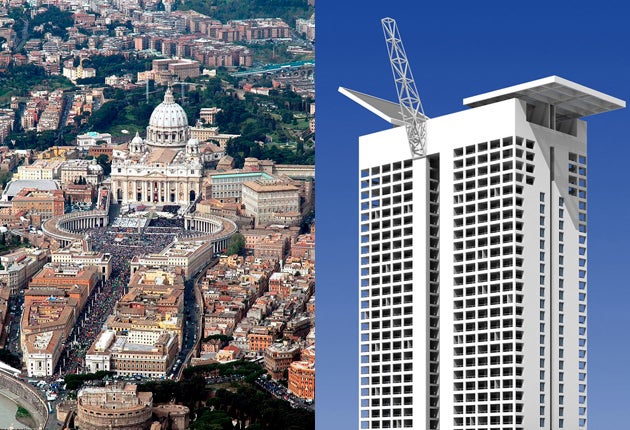Rome divided over building of 120m-high 'eco-monster'

Rome's glorious cityscape, with its jumble of architecture from the ancient world to 20th-century brutalism by way of the medieval, Renaissance and baroque, has just one notable omission – a skyscraper. But this is about to change with the construction of a 30-floor tower that will drag the Eternal City's skyline into the 21st century and is bitterly dividing opinion in the process.
Construction of the 120m-high apartment block, dubbed the Eurosky Tower, is under way in the EUR district on the southern flank of Rome. When completed next year, the building will be among the tallest in Italy.
Designer Franco Purini has conjured two vertical blocks covered in granite and linked by bridges. "We shouldn't forget that in medieval times this city was full of towers," he said, apparently seeking to head off his detractors. Despite these medieval influences, Eurosky, he said, is to be "wholly eco-sustainable" with solar panels and biofuel power systems and even channels to deliver rainwater to plants and flowers.
However, Teodoro Buontempo, who is in charge of housing for the wider Lazio region, is not convinced that the Eurosky Tower provides the answer to the Italian capital's deprived suburbs. "Rome does not need eco-monsters, either vertical or horizontal," he said. "The real challenge will be to give the outskirts of the city some services – sewerage systems, wiring, roads. That's good administration."
Those defending the plans to develop EUR – short for Esposizione Universale Roma, the district conceived by Benito Mussolini to celebrate two decades of Italian fascism – claim it will provide much-needed housing. Critics point out the helipad, and question who will really benefit from the development.
However, it is the aesthetic argument that is raging most fiercely. The Vatican – in the form of Cardinal Giovanni Cheli – told La Repubblica newspaper that he would not want to see "a tower, 30m high, right in front of the Vatican".
Rome's mayor, Gianni Alemmano, appears to have convinced church leaders that the building will be sufficiently far away – five miles south of Papal headquarters – so as not to clash with St Peter's Basilica, the skyline's tallest structure.
And indeed, the Eurosky Tower appears to stick to the unwritten rule that all buildings in the Italian capital must be lower than the famous 138m-high dome, although Mr Purini denies altering his original plans to conform. However, his vertiginous creation may not the last. To the delight of modernists, Mr Alemanno – apparently keen to demonstrate his political transformation from neo-fascist boot-boy to modern-right politician – recently hosted a conference of big-name architects, which considered ways to incorporate additional buildings into the Roman skyline.
At this meeting last month, it emerged that other high-profile projects, including a residential tower by Renzo Piano and a "nuvola" (cloud) conference centre by Massimilano Fuksas, are also on the cards.
There are only 23 buildings in Italy that are 100m high or taller, and most of these are in the northern industrial hubs of Milan and Turin. The most famous, Milan's 1958 Pirelli Building, is considered a classic and is thought to have influenced the design of New York's Pan Am building.
But there are 27 100m-plus buildings in the pipeline. Milan, in particular, is seeing a burst of construction ahead of the 2015 World Fair. Four of these skyscrapers are due to measure in at more than 170m, but that is still roughly only half the size of the Eiffel Tower in Paris, and pales besides American behemoths and rivals sprouting up in the Far East.
Some leading architects have suggested that Italy, with its treasure trove of baroque and classical buildings, has never shown much interest in modern architecture. At the end of last year, Frank Gehry, whose 76-floor Beekman Tower is soon to be inaugurated in Manhattan, told The Independent that Italy had turned its nose up at avant-garde architecture, with his proposals for buildings in Modena, Rome and Venice coming to nothing.
Mr Purini begs to differ. With forward-thinking works by himself and the likes of Piano and Fuksas in the offing, "things are about to change – even in Rome itself," he said. "The city needs new buildings and it's going to get them."
Subscribe to Independent Premium to bookmark this article
Want to bookmark your favourite articles and stories to read or reference later? Start your Independent Premium subscription today.

Join our commenting forum
Join thought-provoking conversations, follow other Independent readers and see their replies